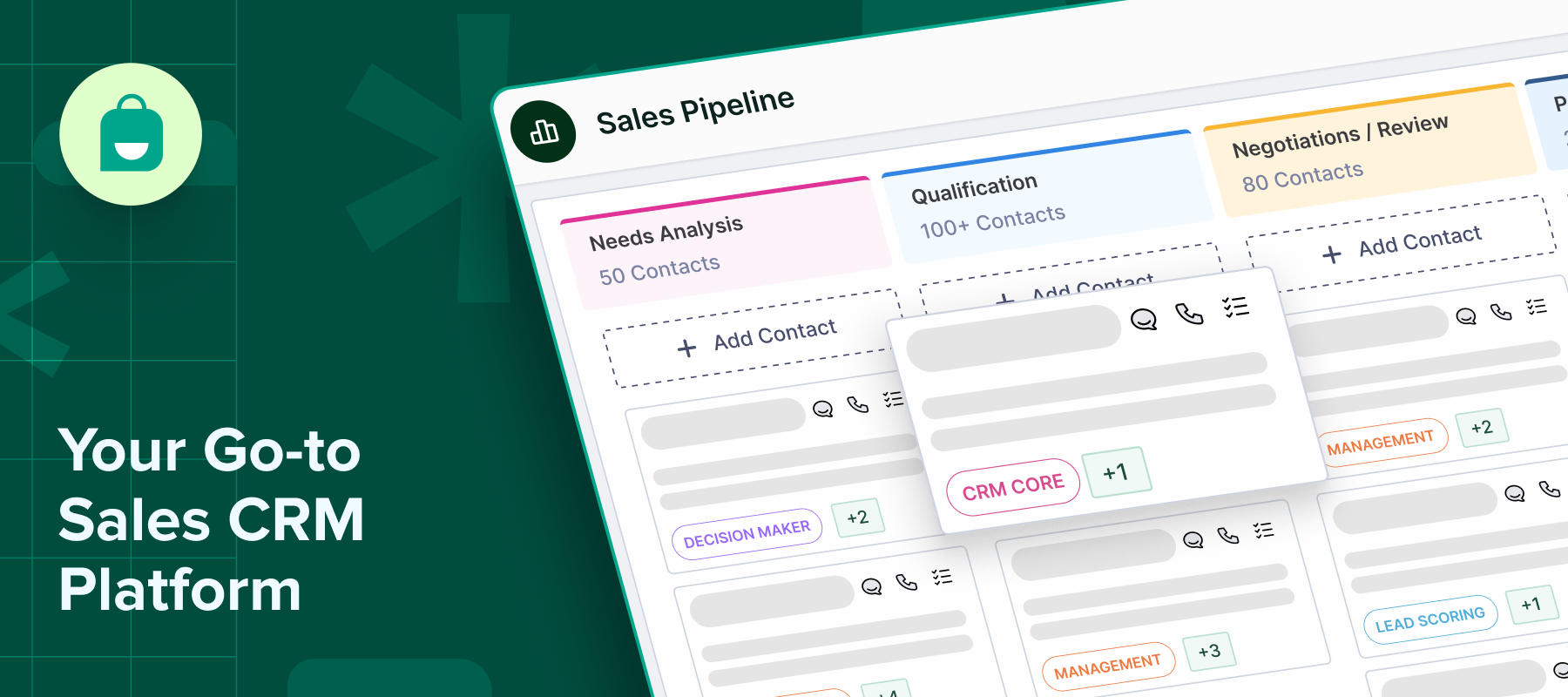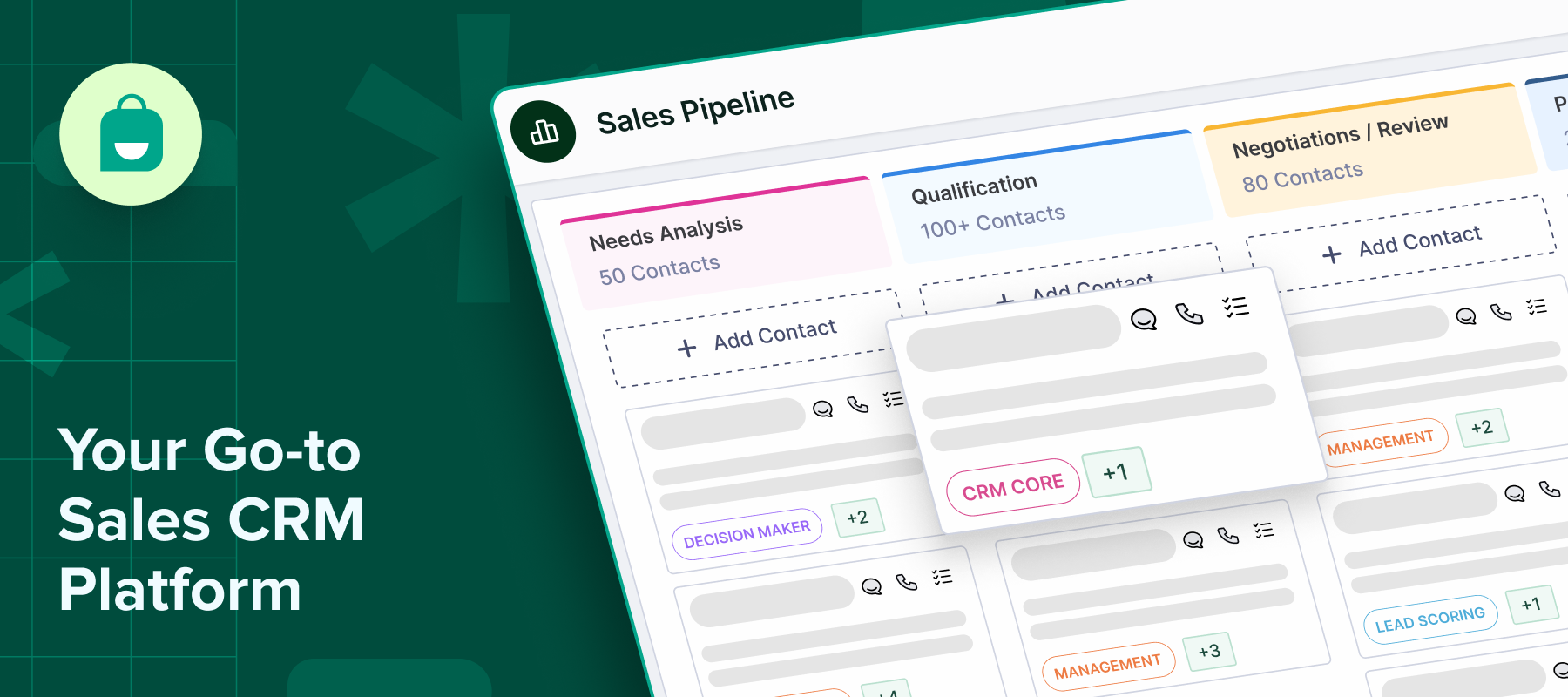Managing a sales pipeline involves tracking every deal from the first contact to a successful close. It’s a simple yet powerful way to ensure no opportunity slips through the cracks.
By knowing exactly where each deal stands, your team can prioritize tasks, address roadblocks quickly, and focus on closing more sales.
The right CRM tool takes this to the next level. It makes the process easier, improves efficiency, and gives your team clear visibility into the pipeline, while strengthening collaboration and reducing the need for manual updates.
In this blog, we’re sharing some of the best sales CRM tools out there, so you can choose the one that fits your needs and helps you improve efficiency and drive sales.
Why Managing Your Sales Pipeline is Crucial
Here’s why managing your sales pipeline is crucial:
1. Provides clear visibility into deal progress and bottlenecks
When you have a clear view of each deal, it’s easier to identify what’s on track and where delays are happening. This allows your team to step in early, keep deals moving, and avoid unnecessary slowdowns.
2. Helps forecast revenue and plan resources accurately
A structured pipeline helps you estimate future revenue with far more accuracy. This makes setting targets, allocating resources, and making informed business decisions easier without relying on guesswork.
3. Enables better follow-ups and reduces lost opportunities
Without proper follow-up, even promising deals can slip away. Managing your pipeline ensures no lead is missed and follow-ups happen on time, improving your chances of closing more deals.
4. Aligns sales activities with business growth goals
With a clear pipeline, your team knows which deals to prioritize to support growth. It keeps daily actions tied to bigger goals, ensuring everyone stays focused on what moves the business forward.
Best CRM Tools for Sales Pipeline Management
Here are some of the best CRM tools for effective sales pipeline management:
1. Interakt CRM
Interakt CRM is a WhatsApp-first sales CRM built to help businesses automate sales, nurture leads, and close deals faster, all within WhatsApp and Instagram. With a fast setup under 30 minutes and the trust of over 50,000 businesses, it’s ideal for teams looking to streamline conversational sales and improve response times.
Key features:
-Lead capture from WhatsApp, Instagram, and APIs
-Automated WhatsApp workflows and personalized messaging
-Unified customer view with interaction and document tracking
-Visual sales pipeline with role-based access and task management
-In-app follow-ups, payment reminders, and WhatsApp payments
-AI-powered insights for better targeting and conversions
-60+ ready-to-use integrations
Pricing:
-₹2,499/month
2. Pipedrive
Pipedrive is an intuitive, AI-powered CRM designed to help sales teams manage pipelines, automate tasks, and close deals more efficiently. With its visual, customizable pipeline and smart automation, it keeps teams focused and drives productivity across the sales process.
Key features:
-AI-powered lead management and deal tracking
-Customizable Kanban-style pipelines
-Sales automation with activity reminders
-Real-time sales insights and forecasting
-500+ integrations via Pipedrive Marketplace
Pricing:
-Essential: $14/user/month
-Advanced: $24/user/month
-Professional: $49/user/month
-Power: $59/user/month
-Enterprise: $79/user/month
3. HubSpot CRM
HubSpot CRM is a flexible, all-in-one platform offering free and paid tools for sales, marketing, service, and operations. It features a visual sales pipeline, real-time tracking, and detailed reporting, helping teams manage contacts and deals more efficiently.
Key features:
-Visual sales pipeline and deal tracking
-AI email writer and meeting scheduler
-Live chat and activity notifications
-Dashboards, reporting, and pipeline management
-Email templates and call tracking
Pricing:
-Starter: $15/month per seat
-Professional: $1,300/month
-Enterprise: $4,700/month
4, Zoho CRM
Zoho CRM is an AI-powered platform that helps businesses scale with advanced workflows, contextual engagement, and deep analytics. It offers a 360° customer view, multi-channel communication, and strong privacy features, making it ideal for growing teams.
Key features:
-Advanced workflows and sales cadences
-AI assistant (Zia) and ChatGPT integration
-Sales forecasting and performance tracking
-Multi-channel customer engagement
-Deep BI and predictive analytics
-1,000+ integrations via Zoho Marketplace
Pricing:
-Standard: ₹1,300/user/month
-Professional: ₹2,100/user/month
-Enterprise: ₹3,000/user/month
-Ultimate: ₹3,200/user/month
5. Freshsales
Freshsales is an AI-powered CRM that helps businesses streamline sales, boost productivity, and close deals faster. With Freddy AI, it delivers smart lead scoring, automated workflows, and actionable insights to keep teams focused.
Key features:
-AI-powered lead scoring and deal insights
-Kanban view for contacts, accounts, and deals
-Multi-channel engagement (chat, email, phone)
-Advanced workflows and sales sequences
-Territory management and custom reports
Pricing:
-Growth: ₹749/user/month
-Pro: ₹3,239/user/month
-Enterprise: ₹4,899/user/month
How to Choose the Right CRM for Your Sales Pipeline
Here’s how you can choose the best CRM for your business:
1. Match features to your sales process complexity
Look at how complex your sales process is. A lightweight CRM with core features may be enough if you handle simple, short sales cycles.
However, if you manage long cycles, multiple deal types, or cross-team collaboration, you’ll need advanced features like multi-stage pipelines, task management, and role-based permissions. Make sure the CRM can scale as your team and processes grow.
2. Prioritize custom pipeline stages and real-time updates
Look for the CRM that lets you customize pipeline stages to match how your team sells. Real-time updates are essential too, so everyone stays in sync and can act quickly when deals move forward or need attention.
3. Consider automation capabilities for lead nurturing and movement
A good CRM should automate repetitive tasks like lead assignments, follow-up reminders, and stage movements based on set conditions. This reduces manual work, improves response times, and ensures no leads fall through the cracks.
4. Look at user adoption, UI simplicity, and reporting depth
A simple, intuitive interface improves adoption and ensures the CRM becomes part of daily workflows. Strong reporting tools are equally important; they help track performance, forecast results, and make data-driven decisions.
Integrating Your CRM with Other Sales Tools
A CRM works best when it’s connected to the tools your sales team already uses. Here’s how to make sure your integrations add real value:
Sync with email marketing and calendar tools
Integrating your CRM with email and calendar tools ensures every outreach, follow-up, and meeting is tracked in one place. This helps your team stay organized, send timely communications, and avoid double-booking or missed follow-ups, improving internal coordination and customer interactions.
Connect with proposal, e-signature, and invoicing software
When your CRM connects to proposal, e-signature, and invoicing tools, it shortens the steps between negotiation and closing. Your team can generate proposals, secure signatures, and send invoices without switching systems, speeding up the deal process and reducing delays or errors.
Use integration with communication platforms
CRM integration with platforms like WhatsApp and Slack keeps sales conversations moving without missing context. Platforms like Interakt combine CRM and WhatsApp, helping teams manage leads, send updates, and respond quickly in one place. This improves team efficiency while keeping customers engaged.
Native vs. Third-Party Integrations
Native integrations are built into your CRM, making setup simple and data sync fast and reliable. They’re updated regularly and offer a smoother user experience with minimal technical effort.
Third-party integration tools like Zapier and Make offer flexibility when native options fall short, letting you connect more apps and automate tasks. While powerful, they often need more setup and can sometimes introduce small delays or extra points to monitor.
The right choice depends on your workflows, the amount of customization you need, and whether your team prioritizes flexibility or simplicity.
Maximizing Your CRM to Improve Pipeline Visibility
Here’s how you can maximise your CRM to improve pipeline visibility:
Use tags, filters, and views to segment deals effectively
Tags, filters, and custom views help your team focus on the right deals. With Interakt CRM, you can tag leads by source, priority, or stage and quickly filter to identify hot prospects, making it easier to work efficiently and avoid missed opportunities.
Leverage dashboards for quick performance overviews
Dashboards offer a real-time snapshot of sales activity, making it easy to spot trends, monitor progress, and address bottlenecks early. Use them to track key metrics like deal stages and response times, keeping reps and managers aligned.
Automate reminders and follow-ups to avoid deal stalling
Automated reminders and follow-ups prevent deals from slipping through the cracks. Set alerts for tasks and stalled deals to maintain momentum. Tools like Interakt CRM help automate this inside messaging apps, improving speed and cutting manual work.
Create custom reports for different team roles
Build custom reports tailored to each role so reps can focus on their pipeline, managers can track team progress, and executives can see the bigger picture. This targeted approach increases accountability and supports better decisions across the team.
Common Pitfalls to Avoid in Sales Pipeline Management
Here are some common challenges in sales pipeline management and how you can avoid them:
-Overcomplicating pipeline stages: Too many stages can confuse your team and slow things down. Keep your pipeline simple and aligned with your sales process.
-Inconsistent data entry: Inaccurate or missing data leads to poor decisions. Set up mandatory fields and automate data capture to keep your pipeline clean and reliable.
-Neglecting old deals: Old or inactive deals clutter your pipeline. Set regular times to review and close out stalled deals to maintain an accurate picture of active opportunities.
-Lack of team alignment: The pipeline becomes unreliable when teams follow different definitions or processes. Ensure everyone understands and uses the same pipeline stages and terms to keep things consistent and effective.
Conclusion
Effective sales pipeline management is key to improving visibility, driving efficiency, and closing more deals. It helps your team stay focused, prioritize the right opportunities, and keep the sales process moving smoothly from start to finish.
The right CRM plays a significant role in making this happen. With Interakt CRM, you can automate routine tasks, track leads across channels like WhatsApp and Instagram, and keep your entire team aligned, all in one platform.


